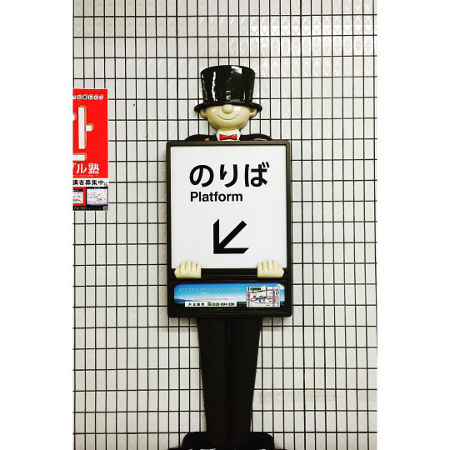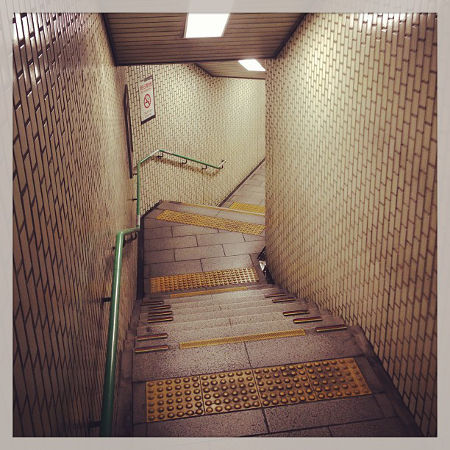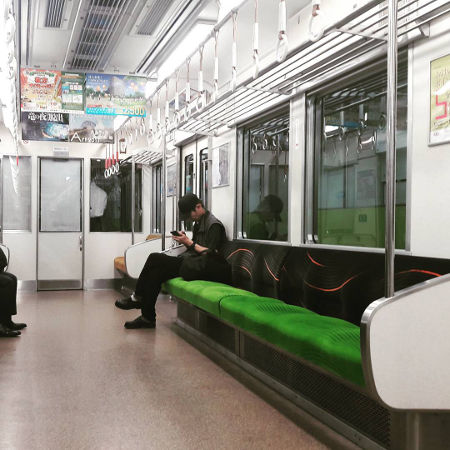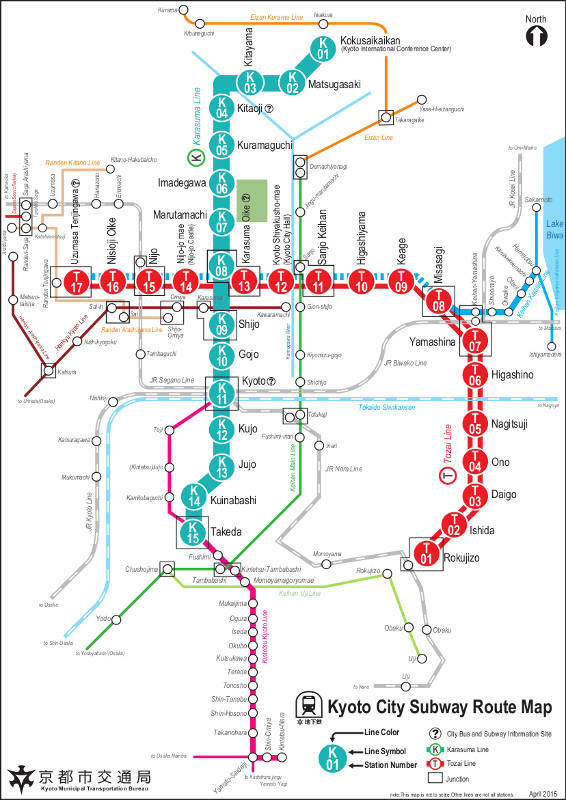The Kyoto Municipal Metro has a total track length of 30 kilometers, which are divided into two lines, and offer services to 32 stations. It transports 387 thousand passengers daily, which is a big ridership for a relatively small train.
The most basic ticket, the ordinary ticket, offers you a trip to one zone, and it costs 210 JPY (1.89 USD.)
It opens its doors at 5:00 a.m., and closes its doors at 11:30 p.m. all week long.
The Kyoto Metro
Kyoto is an important cultural, symbolic, and patrimonial center in Japan. It is a city located on the Honshu Island. It served as the capital of the country until 1868, year in which the emperor decided to move the imperial court to Tokyo, ultimately changing the executive branch of the Japanese nation.
Kyoto has slightly over 1,460,000 inhabitants, which makes it a city of relatively low population, since this only represents a really small fraction of the total population of Japan, which is of 129 million inhabitants. However, even though it is a small city, its cultural richness makes it one of the main touristic destinations of the nation, since it receives hundreds of thousands of tourists each year.
Kyoto currently has a modern and developed public transportation system. This modernization was partly caused by the industrialization that Japan experimented during the post-war.
Roads, highways, railways, bus lines, and the Kyoto Metro are some of the city´s highlights in regards to transportation structures.
This last transportation system, the subway, began operation on May 29th, 1981, after a decade of research about the sustainability of the project. It has 30 kilometers of rails, divided into two lines, having a total of 32 stations. The Kyoto Metro may be considered a metro of small size, but it transports 387 thousand passengers per day. Therefore, despite of its small size, it is a highly demanded transportation service.
Lines and stations
The Kyoto Metro has two commercial lines, which connect the city from the east to the west, and from the north to the south. Both lines offer a 30 kilometer-long journey, connecting many residential neighborhoods with the downtown area.
Also, the trains transit through 32 stations in total, which tend to have a high influx of passengers. There are so many users on the system, that its daily ridership represents more than a fourth of Kyoto´s total population.
 Kyoto Municipal Subway
Kyoto Municipal Subway
Karasuma Line
The Karasuma line is operated by Kyoto´s Municipal Office of Transportation, which is the entity in charge of managing the city´s public transportation. It is marked in green on the metro´s maps. Also, its stations have the letter “K”, followed by a number that is used to indicate which stop belongs to which line.
It has a 13.7 kilometer-long track, and it is present between the north and the south of Kyoto. It begins at the Sakyō-ku neighborhood, and it ends at the Fushimi-ku region, and the journey between both places is done through 15 commercial stations.
Stations
- Kokusaikaikan Station (国際会館): It is located on the Sakyo-ku neighborhood, to the north of the city. Its identification number is “K-01”.
- Matsugasaki Station (松ヶ崎): It is located on the Sakyo-ku neighborhood, to the north of the city. Its identification number is “K-02”.
- Kitayama Station (北山): It is located on the Kita-ku neighborhood, to the north of the city. Its identification number is “K-03”.
- Kitaōji Station (北大路): It is located on the Kita-ku neighborhood, to the north of the city. Its identification number is “K-04”.
- Kuramaguchi Station (鞍馬口): It is located on the Kamigyō-ku neighborhood, adjacent to the downtown area. Its identification number is “K-05”.
- Imadegawa Station (今出川): It is located on the Kamigyō-ku neighborhood, adjacent to the downtown area. Its identification number is “K-06”.
- Marutamachi Station (丸太町): It is located on the Nakagyō-ku neighborhood, right at the center of the downtown area. Its identification number is “K-07”.
- Karasuma Oike Station (烏丸御池): It is located on the Nakagyō-ku neighborhood, right at the center of the downtown area. Its identification number is “K-08”.
- Shijō Station (四条): It is located on the Shimogyō-ku neighborhood, right at the center of the downtown area. Its identification number is “K-09”.
- Gojō Station (五条): It is located on the Shimogyō-ku neighborhood, right at the center of the downtown area. Its identification number is “K-10”.
- Kyoto Station (京都): It is located on the Shimogyō-ku neighborhood, right at the center of the downtown area. Its identification number is “K-11”.
- Kujō Station (九条): It is located on the Minami-ku neighborhood, to the south of the city. Its identification number is “K-12”.
- Jūjō Station (十条): It is located on the Minami-ku neighborhood, to the south of the city. Its identification number is “K-13”.
- Kuinabashi Station (くいな橋): It is located on the Fushimi-ku neighborhood, to the south of the city. Its identification number is “K-14”.
- Takeda Station (竹田): It is located on the Fushimi-ku neighborhood, to the south of the city. Its identification number is “K-15”.

Tōzai Line
The Tōzai line has stops at the southwestern, eastern, and western ends of Kyoto, serving a total of 17 stations. It has been operational since October 12th, 1997, when it was inaugurated. It currently satisfies the transportation demand of 120 thousand passengers per day.
Additionally, it has a 17.5 kilometer-long railway, and there are no current plans of expanding it in the near future. It is easy to identify thanks to its signature orange color on the system´s maps, and for the letter “T”, which is added before the code of each station it serves.
Stations
- Rokujizō Station (六地蔵駅): It is located on the Uji neighborhood, to the southeast of the city. Its identification number is “T-01”.
- Ishida Station (石田駅): It is located on the Fushimi-ku neighborhood, to the south of the city. Its identification number is “T-02”.
- Daigo Station (醍醐駅): It is located on the Fushimi-ku neighborhood, to the south of the city. Its identification number is “T-03”.
- Ono Station (小野駅): It is located on the Yamashina-ku neighborhood, to the southeast of the city. Its identification number is “T-04”.
- Nagitsuji Station (椥辻駅): It is located on the Yamashina-ku neighborhood, to the southeast of the city. Its identification number is “T-05”.
- Higashino Station (東野駅): It is located on the Yamashina-ku neighborhood, to the southeast of the city. Its identification number is “T-06”.
- Yamashina Station (山科駅): It is located on the Yamashina-ku neighborhood, to the southeast of the city. Its identification number is “T-07”.
- Misasagi Station (御陵駅): It is located on the Yamashina-ku neighborhood, to the southeast of the city. Its identification number is “T-08”.
- Keage Station (蹴上駅): It is located on the Higashiyama-ku neighborhood, to the east of the city. Its identification number is “T-09”.
- Higashiyama Station (東山駅): It is located on the Higashiyama-ku neighborhood, to the east of the city. Its identification number is “T-10”.
- Sanjō Keihan Station (三条京阪駅): It is located on the Higashiyama-ku neighborhood, to the east of the city. Its identification number is “T-11”.
- Kyōto Shiyakusho-mae Station (京都市役所前駅): It is located on the Nakagyō-ku neighborhood, on the city´s downtown area. Its identification number is “T-12”.
- Karasuma Oike Station (烏丸御池駅): It is located on the Nakagyō-ku neighborhood, on the city´s downtown area. Its identification number is “T-13”.
- Nijōjō-mae Station (二条城前駅): It is located on the Nakagyō-ku neighborhood, on the city´s downtown area. Its identification number is “T-14”.
- Nijō Station (二条駅): It is located on the Nakagyō-ku neighborhood, on the city´s downtown area. Its identification number is “T-15”.
- Nishiōji Oike Station (西大路御池駅): It is located on the Nakagyō-ku neighborhood, on the city´s downtown area. Its identification number is “T-16”.
- Uzumasa Tenjingawa Station (太秦天神川駅): It is located on the Ukyō-ku neighborhood, to the west of the city. Its identification number is “T-17”.

Connections
The Kyoto Metro has many connections throughout its stations, especially for the bus stops adjacent to its disembarking sites. Below, you will see the stations that have at least one type of access to other public transportation systems.
Karasuma Line
- Kokusaikaikan Station: It has a connection with the buses from lines 5, 31, 65, 24, 26, 46, 29, 40, 45, 19, 50 and 52.
- Kitayama Station: It has a connection with the buses from lines 4, 8, 45, 46 and 30.
- Kitaōji Station: It has a connection with the buses from lines 3, 204, 206, 1, 37, 205, 8, 101, 102, M1, 30, 32, 34, 35, 45 and 46.
- Marutamachi Station: It has connections with the buses from lines 10, 51, 65, 93, 202, 204, and 45.
- Karasuma Oike Station: It has connections with the buses from lines 15, 51, 65, 45, 62, 63, 64, 66 and 67. It also connects with the “T-13” station from the Tōzai line.
- Kyoto Station: It has connections with the buses from lines 5, 4, 17, 104, 205, 206, 9, 50, 101, 86, 88, 103, 110, 208, 14, 15, 26, 28, 21, 27, 26B, 28A, 21A, 18, 19, 22, 78, 81 and 33. It also makes connections with Central Japan Railway Company, West Japan Railway Company and Kintetsu Railway train firms, which have mid-distance and long-distance trains.
- Kujō Station: It has a connection with the buses from lines 16, 202, 207, 26, 19, 71, 78, 81, 88 and 208.
- Takeda Station: It has connections with the buses from lines 81, 105, 5, 8, 2, 10, 18, 1, 3, 6, 24 and 24A. It also connects with the company Kintetsu Railway.
Tōzai Line
- Rokujizō Station: It has connections with the buses from lines 101, 108, 118, 138, 128, 22, 22A, 8, 3, 87A, 87B, 88B, 100, 107, 117 and 127. It also makes transfers to the Keihan Uji Line and West Japan Railway Company train firms.
- Daigo Station: It connects with the buses from lines 2, 3, 6, 83, 84, 87A, 87B and 88B.
- Yamashina Station: It has connections with the buses from lines 19, 20, 21, 22, 24, 24A, 26, 26A, 28A, 29, 29A, 45, 47 and 48. It also connects with the West Japan Railway Company y Keihan Electric Railway companies.
- Misasagi Station: It has a connection with the buses from lines 17 and 19. It also connects with the trains from the company called Keihan Electric Railway.
- Higashiyama Station: It has a connection with the buses from lines 5, 12, 31, 46, 201, 202, 203, 206, 86 and 110.
- Sanjō Keihan Station: It has a connection with the trains from the company called Keihan Railway.
- Kyōto Shiyakusho-mae Station: It has connections with the buses from lines 4, 5, 10, 15, 17, 32, 37, 51, 59, 104 and 205.
- Karasuma Oike Station: It has a connection with the buses from lines 15, 51, 65, 45, 62, 63, 64, 65, 66 and 67. It also connects with the line called Karasuma.
- Nijō Station (Airport): It has connections with the buses from lines 18, 58, 69, 6, 15, 46, 55, 69, 201, 206, 62, 63, 64, 65, 66 and 67. It also connects with the West Japan Railway Company train firm.
- Nishiōji Oike Station: It has a connection with the buses from lines 26, 27, 75, 91, 202, 203 and 205.
- Uzumasa Tenjingawa Station: It has a connection with the buses from lines 8, 11, 27, 70, 71, 75, 80, 84 and 93.
Fares
The authorities of the Kyoto Metro establish fares according to the number of zones that the user travels, offering journeys from one zone, up to five zones. If you want to know more information, the fares chart is available on the metro´s official website. Likewise, the passengers can use the classic tickets to access the subway system, or buy a reloadable card called the IC Card.
Ordinary ticket (Adult):
They are valid for a single ride, and their price depend on the number of zones that the passenger goes to.
- 1 Zone: 210 JPY (1.89 USD).
- 2 Zones: 260 JPY (2.34 USD).
- 3 Zones: 290 JPY (2.61 USD).
- 4 Zones: 320 JPY (2.88 USD).
- 5 Zones: 350 JPY (3.15 USD).
Ordinary ticket (Children)
They are valid for a single ride, and their fare is subject to the number of zones that the passenger goes to.
- 1 Zone: 110 JPY (0.99 USD).
- 2 Zones: 130 JPY (1.17 USD).
- 3 Zones: 150 JPY (1.35 USD).
- 4 Zones: 160 JPY (1.44 USD).
- 5 Zones: 180 JPY (1.62 USD).
The subway one-day pass
They are valid all day long, and they do not have a zone limit, so the user will have to pay only one price.
- Adults: 600 JPY (5.40 USD).
- Children: 300 JPY (2.70 USD).
Commutation 1 month
Plan available for users with the IC Cards, which allows you to have a whole month worth of journeys on the Kyoto subway.
- 1 Zone: 9,070 JPY (81.99 USD).
- 2 Zones: 10,800 JPY (97.63 USD).
- 3 Zones: 12,100 JPY (109.38 USD).
- 4 Zones: 13,390 JPY (121.05 USD).
- 5 Zones: 14,690 JPY (132.80 USD).
Commutation 3 months
Plan available for the users with the IC Cards, which allows you to have three months’ worth of journeys on the Kyoto subway.
- 1 Zone: 25,850 JPY (233.68 USD).
- 2 Zones: 30,780 JPY (278.25 USD).
- 3 Zones: 34,490 JPY (311.79 USD).
- 4 Zones: 38,170 JPY (345.06 USD).
- 5 Zones: 41,870 JPY (378.50 USD).
Commutation 6 months
Plan available for the users with the IC Cards, which allows you to have six months’ worth of journeys on the Kyoto subway.
- 1 Zone: 48,980 JPY (442.78 USD).
- 2 Zones: 58,320 JPY (527.21 USD).
- 3 Zones: 65,340 JPY (590.67 USD).
- 4 Zones: 72,310 JPY (653.68 USD).
- 5 Zones: 79,330 JPY (717.14 USD).
Going to school: The back (1 month)
Plan available for the college and secondary school students who have an IC Cards. It is valid for a month.
College students
- 1 Zone: 6,480 JPY (58.58 USD).
- 2 Zones: 7,710 JPY (69.70 USD).
- 3 Zones: 8,640 JPY (78.11 USD).
- 4 Zones: 9,570 JPY (86.51 USD).
- 5 Zones: 10,490 JPY (94.83 USD).
Secondary school students
- 1 Zone: 5,180 JPY (46.83 USD).
- 2 Zones: 6,170 JPY (55.78 USD).
- 3 Zones: 6,910 JPY (62.47 USD).
- 4 Zones: 7,650 JPY (69.16 USD).
- 5 Zones: 8,390 JPY (75.85 USD).
Going to school: The back (3 month)
Plan available for the college and secondary school students who have an IC Cards. It is valid for three months.
College students
- 1 Zone: 18,470 JPY (166.97 USD).
- 2 Zones: 21,980 JPY (198.70 USD).
- 3 Zones: 24,630 JPY (222.66 USD).
- 4 Zones: 27,280 JPY (246.61 USD).
- 5 Zones: 29,900 JPY (270.30 USD).
Secondary school students
- 1 Zone: 14,770 JPY (133.52 USD).
- 2 Zones: 17,590 JPY (159.01 USD).
- 3 Zones: 19,700 JPY (178.09 USD).
- 4 Zones: 21,810 JPY (197.16 USD).
- 5 Zones: 23,920 JPY (216.24 USD).
Going to school: The back (6 month)
Plan available for the college and secondary school students who have an IC Cards. It is valid for six months.
College students
- 1 Zone: 35,000 JPY (316.40 USD).
- 2 Zones: 41,640 JPY (376.43 USD).
- 3 Zones: 46,660 JPY (421.81 USD).
- 4 Zones: 51,680 JPY (467.19 USD).
- 5 Zones: 56,650 JPY (512.12 USD).
Secondary school
- 1 Zone: 27,980 JPY (252.94 USD).
- 2 Zones: 33,320 JPY (301.21 USD).
- 3 Zones: 37,320 JPY (337.37 USD).
- 4 Zones: 41,310 JPY (373.44 USD).
- 5 Zones: 45,310 JPY (409.60 USD).
Schedule
The Kyoto Metro´s business hours are quite convenient for its users, so that they can move around the city easily. It begins to operate since 5:00 a.m., and it ceases to operate at 11:30 p.m. These hours apply all week long, regardless of the presence of a holiday during the week. However, during holidays, you will notice on the platforms that the train frequency varies.
Usually, the vehicles arrive each six or 7 minutes during the regular course of the day. But, during peak hours, the waiting time is reduced to just three or four minutes. During the night, after 9:30 p.m., the waiting times increase significantly, since the passengers need to wait 8 or 10 minutes for each train to arrive.
Rules
- Bags and suitcases transported by a user should not obstruct the way of other passengers walking by.
- For your safety, you will need to avoid crossing the yellow line. Otherwise, you may be fined.
- Children older than four need their own ticket to travel on the Kyoto Metro.
- You cannot smoke on neither the stations nor the system´s trains.
- It is prohibited to carry fireworks and flammable objects with you.
- You cannot enter the Kyoto Metro´s facilities while drunk or under the influence of drugs.
- If you wish to remain standing while on the escalator, stay on the left side of it. This way, people who are in a hurry will be able to walk to your right.
- Make sure to wear headphones while reproducing multimedia content on the wagons, so that you do not disturb the other passengers.
- You cannot sell merchandise on the Kyoto Metro´s facilities, unless you have been previously authorized.
- You cannot beg on the spaces within the metro´s facilities. Said action may result in an expulsion from the facilities.
- In case of emergency, follow the instructions of the service´s personnel.
- Avoid activating or manipulating the emergency devices unless you face a real threat.
- You should make sure to not to disturb other passengers with actions that may be bothersome to others. Trying to emotionally or physically assault other users will result in fines given by the authorities.
Connection to the airport
The city of Kyoto does not have its own airport, so the visitors will need to go to Osaka. This airport is the Kansai International Airport, located 100 kilometers from Kyoto. Even though it may seem like a long distance, the journey turns out to be quite fast, thanks to the good infrastructure that Japan has.
To reach the Kansai airport, the users will go to the “Kyoto” station from the Karasuma line. There, you should disembark, and acquire a Haruka Express ticket -a train that connects the city to the airport-, for 1,880 JPY (17.00 USD.) After buying your ticket, you will only need to board the train, which will take you to Kansai in a 75 minute-long journey.
The journey is the same in the opposite direction, since the Haruka Express stop is located a few meters from the airport. It is also noteworthy the fact that these vehicles also make a stop in Osaka, if you wish to make a visit to said city before reaching Kyoto.
Metro map of Kyoto
Map via www2.city.kyoto.lg.jpSee map full resolution. It may take a little bit to load.
Download map.
Kyoto Kyoto Municipal Subway map
- Also Known As: Kyoto Municipal Subway
- Passengers/Day 345000
- Fares:
- 24h operation: No
- Air Conditioning: No
- Walk between platforms: Yes
- Driverless trains: No
- Screen Doors Platforms: Tozai line
- Average Speed: 75km/h
- 210-350 Yen
- Kyoto Metro Official Website
- Tlf: 075-371-9866
Help us
If you consider that the information we provide is wrong, not accurated, outdated, translation contains errors, and you would like to help us to improve the file...you can contact us here.
Feel free to contact us if you dont find the system you're looking for and we'll add it as soon as we can!
Thank you very much!







